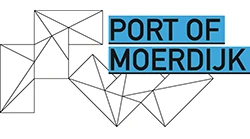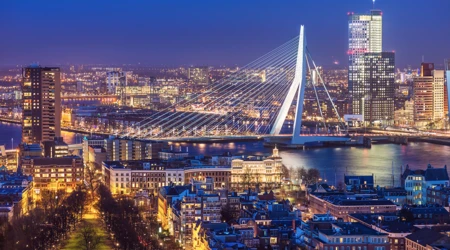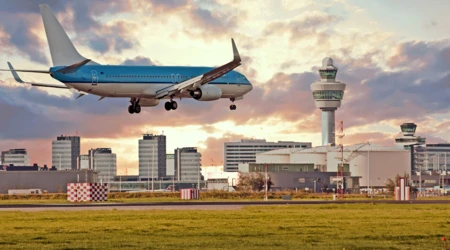Cargo corridor development
Companies, governments (local, regional or national) and society all have a major interest in the effective development of the important transport corridors in Europe. The flows of goods run through the ports and inland nodes on these corridors.
With our extensive market knowledge and self-developed analysis tools, we help governments and companies to achieve their sustainable and economic business and policy goals in these areas. We do this by, among other things, working on sufficient public and/or private truck parking facilities with the right facilities, inland shipping berths with shore power connections and better access to railway yards. In addition, the focus is on the optimal use of the scarce space of business parks along the transport corridors, for example through multiple use of space and the inclusion of circular activities. Finally, the development of clean energy hubs to implement the energy transition in practice is an important building block in our vision for the development of transport corridors, ports and inland terminals.
Our team has years of experience in the better and more sustainable design and use of ports, inland terminals, infrastructure and scarce space on transport corridors. We advise companies on how to reduce their carbon footprint and set up profitable multimodal services. By combining our in-depth knowledge of logistics business processes with the desired infrastructure policy and challenging government tasks, we can come up with smart and innovative solutions. In doing so, we focus on innovation where possible and desired: the development of synchromodal transport, in which modalities can be used seamlessly side by side, is a practical example. In this way, we offer solutions that help you as optimally as possible in making transport more sustainable, developing infrastructure or ports/terminals and strengthening transport corridors.
Companies, governments (local, regional or national) and society all have a major interest in the effective development of the important transport corridors in Europe. The flows of goods through the ports and inland nodes on these corridors, which ensure broader prosperity, run through them.
Companies want to make the transport of goods more sustainable in order to contribute to the climate objectives of the Netherlands and the EU (Green Deal and Fit for 55). To be able to do so, they must be able to use different modes of transport on these international transport corridors: road, inland shipping, rail, pipeline. Investment in better use of the multimodal infrastructure on these corridors is therefore essential. This includes the construction of truck parking and berths, clean energy hubs for biodiesel, e-charging and hydrogen, digitization of messaging and efficient use of scarce space.
At BCI, we believe that in Northwest Europe, governments and companies must work together effectively to ensure that the (inter)national transport corridors East/North Sea Baltic, Southeast/Rhine-Alpine and South/North Sea-Mediterranean continue to be the most efficient and sustainable in Europe in the future (2030/2040). These transport corridors, and the port and nodes on these corridors, are essential for the creation of broad prosperity for our European society. It is important to make better use of the multimodal infrastructure, to optimize the logistical accessibility of hubs, to facilitate sustainable freight transport as much as possible and to make optimal use of scarce space.



To help companies and governments make logistics and transport in ports and hubs and across transport corridors more sustainable, BCI Global deploys a number of tailor-made approaches and analysis tools. We have developed these approaches and tools together with partners based on research and experiences with our government and corporate customers:
Corridor/hub Connectivity Tool
If you want to strengthen a transport corridor or hub (port/inland node) or want to get an idea of what actions are needed from different stakeholders, we can provide insight into this using our "Corridor/Hub Connectivity Tool". Together with you, we draw up a tailor-made set of quantitative and qualitative criteria for the corridors, make an analysis of the development opportunities and give an assessment with recommendations for sustainable development of the corridors. The scores on the criteria are substantiated with data and interviews. Practical example: BCI has used this Corridor/Hub Connectivity Tool in the feasibility study for the MIRT South/North Sea Mediterranean Freight Corridor program.
Goods flow analysis
If you want to better control the transport of goods on certain transport corridors or have it carried out via modalities other than road, we can advise you by carrying out an analysis of these goods flows. In doing so, we look at current and future volumes, hubs and nodes used, type of goods and the various modalities (road, rail, inland shipping, pipelines, aviation, etc.) and the most important companies. If desired or necessary, we supplement this analysis with a benchmark (cost and quality) of freight flows and modalities on other routes. In the end, we come to an opinion about the most optimal (in terms of costs, sustainability, time, quality) transport options. Practical example: BCI has made these goods flow analyses for the MIRT program Freight Corridor East/North Sea-Baltic and South-East/Rhine-Alpine.
Carbon footprint Tool
BCI supports companies in setting up and carrying out transport and logistics operations in a more sustainable way through the Carbon Footprint Tool. In doing so, we make an analysis of the way in which your current services are carried out and what developments there are in your specific sector/market to make transport and logistics operations more efficient or sustainable. We then make a carbon footprint analysis via our tool, which gives the client insight into the current CO2 emissions of transport and logistics and the most effective actions to reduce them. BCI we work for many companies and governments to achieve sustainable logistics. Based on our analyses, we give you advice on how certain transports can be carried out more efficiently and/or sustainably. Practical example: BCI has used its Carbon Footprint tool for more than 50 companies in various sectors, giving these companies insight into concrete CO2 savings opportunities.















